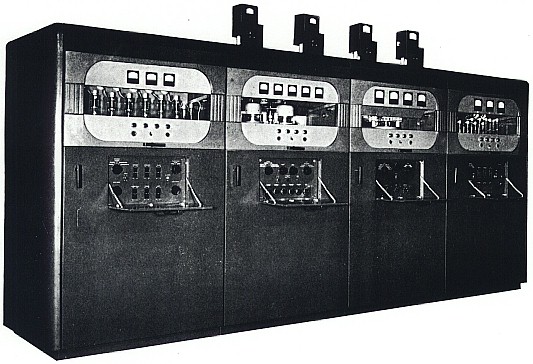| GENERAL DESCRIPTION |
 PURPOSE
PURPOSE| TECHNICAL SPECIFICATIONS | |
| Total Cubical Contents | |
| Total Weight | |
| Frequency Range | 4000 to 26000 kilocycles |
| Frequency Multiplier Range | 4 to 26 megacycles |
| First Frequency Multiplier | 4 to 13 megacycles |
| Second Frequency Multiplier | 4 to 26 megacycles |
| Type of Frequency Control | Crystal or Stabilized Oscillator |
| Type of Emission | a. A-1 (carrier ON-OFF) b. Frequency shift |
| Keying Speed | Up to 400 wpm both off-on and frequency shift emission |
| Nominal Carrier Output for each type of Emission | a. 40 kilowatts for A-1 emission, into a fixed 600 ohm load with a maximum SWR of 2 to 1 b. 40 kilowatts for frequency shift emission into fixed 600 ohm load with maximum SWR of 2 to 1 |
| Power Factor of Equipment | a. Starting: 82.5% (High Voltage Off) b. Standby: 80.5% (Key Open) c. Normal Operation: 96% |
| Power Source Requirements | a. Voltage: 207 to 253 volts; designed for a center voltage of 230 volts b. Frequency: 60 cps ±5% c. Number of Phases: 3 Phase d. Input Power: Key Down: 86 kw; Key Up: 156 kw; High Voltage Off: 11.2 kw |
| Crystal | Type AN/CR27-U with fundamental frequency between 2.0 and 4.2 mc required (Not Supplied by Contractor) |
| TUBE COMPLEMENT | |||||
| RF stages | AF stages and modulator | Rectifiers | |||
| Number | Type | Number | Type | Number | Type |
| 8 | 2C51 | 8 | 3B28 | ||
| 8 | 3X2500A3 | 18 | 4B32 | ||
| 1 | 4-400A | 3 | 5R4GYW | ||
| 5 | 5686 | 2 | OA2 | ||
| 2 | 6AS6 | 1 | 6X4 | ||
| 9 | 6AK5 | ||||
| 5 | 6BE6 | ||||
| 5 | 6BA6 | ||||
| 4 | 6AL5 | ||||
| 2 | 6SJ7 | ||||
| 10 | 6X4 | ||||
| 2 | 6AG7 | ||||
| 3 | 807 | ||||
| 11 | 12AU7 | ||||
| 10 | 12AX7 | ||||
| 1 | 6C4 | ||||
| 2 | VR90 | ||||
| THIS TYPE OF TRANSMITTER IS INSTALLED IN THE FOLLOWING COUNTRIES | |||||
| ITU | Country | ITU | Country | ||
| LBR | LIBERIA | ||||